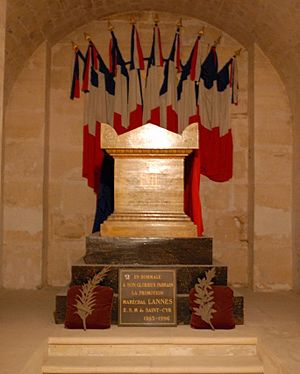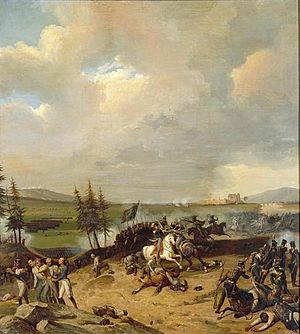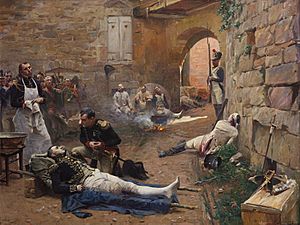Jean Lannes facts for kids
Quick facts for kids
Marshal of the Empire
Jean Lannes
Duke of Montebello, Prince of Siewierz
|
|
|---|---|

Lannes in the uniform of colonel of the hussars, by Jean-Charles Nicaise Perrin (between 1805–1810)
|
|
| Nickname(s) | Roland of the Grande Armée, Achilles of the Grande Armée |
| Born | 10 April 1769 Lectoure, Guyenne-Gascony, Kingdom of France |
| Died | 31 May 1809 (aged 40) Ebersdorf, Lower Austria, Austria |
| Buried | |
| Allegiance | |
| Service/ |
Army |
| Years of service | 1792–1809 |
| Rank | Marshal of the Empire |
| Battles/wars | |
| Awards | Grand Cross of the Legion of Honour Commander of the Order of the Iron Crown Duke of the Empire |
| Spouse(s) |
Paulette Méric
(m. 1795; ann. 1800)Louise Antoinette Lannes, Duchess of Montebello
(m. 1800) |
| Relations | Gustave Olivier Lannes de Montebello (son) |
| Signature | |
Jean Lannes, the 1st Duke of Montebello and Prince of Siewierz (born April 10, 1769 – died May 31, 1809), was a brave French military leader. He became a Marshal of the Empire and fought in both the French Revolutionary and Napoleonic Wars.
Many people think he was one of Napoleon's most daring and skilled generals. Napoleon himself once said about Lannes: "I found him a pygmy and left him a giant." Lannes was a close friend of Napoleon. He was even allowed to use the informal "tu" when speaking to the emperor, instead of the more formal "vous."
Contents
Early Life and Military Start
Jean Lannes was born in a small town called Lectoure in Southern France. His father was a small landowner and merchant. Jean didn't get much formal schooling.
However, he was very strong and good at many sports. In 1792, when war broke out between France and Spain, he joined a group of volunteers. Because of his skills, he was quickly chosen as a sergeant-major.
Fighting in the Pyrenees
Lannes fought under General Jean-Antoine Marbot in the Pyrenees mountains from 1793 to 1794. He showed great courage and quickly rose through the ranks. He became a chef de brigade, which is like a colonel.
During this time, General Jacques François Dugommier gave Lannes important tasks. Future Marshal Louis-Nicolas Davout also recommended him for promotion.
Campaigns in Italy and Egypt

Lannes served under General Barthélemy Louis Joseph Schérer and fought in the Battle of Loano. In 1795, he was temporarily removed from his rank due to army changes. But he didn't give up! He rejoined the French army in Italy as a simple volunteer.
Rising Through the Ranks in Italy
Lannes fought in the Italian campaign of 1796. He quickly earned back his high rank. He commanded a brigade and later led advance troops. He was brave in every battle.
He played a key role in the victory at Dego. At the Battle of Bassano, he bravely captured two enemy flags himself. He was wounded many times at the Battle of Arcole but kept leading his soldiers.
Lannes also led troops into the Papal States. Once, he and a small group met 300 enemy cavalry. He cleverly ordered them to return to base, convincing them not to attack. This avoided a dangerous fight.
Adventures in Egypt
Napoleon Bonaparte chose Lannes to go with him to Egypt. Lannes commanded a brigade there and showed great bravery. He was especially noted during the difficult retreat from Syria.
Lannes was wounded at the Battle of Abukir. After this, he returned to France with Bonaparte. He helped Bonaparte in the Coup of 18 Brumaire, which was when Bonaparte took power.
After Bonaparte became Consul of France, Lannes was promoted. He became a general of division and commander of the consular guard.
Return to Italy and Key Victories
Lannes then returned to the army in Italy. He led the advance guard when the army crossed the Alps in 1800. He was very important in winning the Battle of Montebello. He later took his noble title from this battle. He also played a big part in the Battle of Marengo.
Napoleonic Wars and Great Success
At one point, Lannes faced financial trouble. But his friend Augereau helped him out. Because of this, Lannes was not completely disgraced. Instead, he was sent as an ambassador to Portugal in 1801.
In 1804, Lannes bought a beautiful old castle near Paris, the Château de Maisons. He even had a special room decorated for a visit from Napoleon.
Becoming a Marshal
When the First French Empire was created, Lannes became one of the first eighteen Marshals of the Empire. In 1805, he fully regained Napoleon's trust.
At the Battle of Austerlitz, he commanded the left side of the French army. During the War of the Fourth Coalition, Lannes was at his best. He led his troops with great skill through the Thuringian Forest.
He was brilliant at the Battle of Saalfeld, which is still studied today as a perfect example of military strategy. He also fought bravely at the Battle of Jena. His leadership of the advance guard at Friedland was even more impressive.
Duke and Commander-in-Chief
In 1807, Napoleon gave Lannes the Duchy of Siewierz. This happened after Prussia had to give up lands from the partitions of Poland.
After this, Lannes was tested as a main commander. Napoleon sent him to Spain in 1808. He gave Lannes a separate part of the army to command. With this force, Lannes won a huge victory over General Francisco Castaños at Tudela on November 22.
In January 1809, he was sent to capture Zaragoza. By February 21, after one of the toughest defenses in history, Lannes took the city. In 1808, Napoleon made him Duke of Montebello.
In 1809, for the last time, Napoleon gave him command of the advance guard. Lannes fought in battles around Eckmühl and led the advance on Vienna. He led the French Army across the Danube River. He and Marshal André Masséna bore the main attack at the Battle of Aspern-Essling.
Death of a Hero
On May 22, 1809, during a break in the second day of the Battle of Aspern-Essling, Lannes sat down by a ditch. He was thinking sadly about his friend, General Pierre Charles Pouzet, who had just been killed by a cannonball.
Suddenly, another cannonball hit him where his legs were crossed. Lannes said, "I am wounded; it's nothing much; give me your hand to help me up." He tried to stand but couldn't.
He was carried to a safe spot where surgeons treated his wound. One of Lannes' legs was amputated very quickly by Dominique Jean Larrey. He was very brave during the painful operation.
Right after, Napoleon came and knelt beside him, crying as he hugged the marshal. On May 23, Lannes was taken by boat to a nice house in Vienna. Eight days later, on May 31, he died from his severe wounds.
He was first buried in Les Invalides in Paris. But in 1810, he was moved and reburied in the Panthéon national building after a grand ceremony.
Family Life
Lannes was married twice. His first marriage was in 1795 to Paulette Méric. They divorced in 1800. His second marriage was in 1800 to Louise Antoinette, Comtesse de Guéhéneuc.
He had five children with Louise Antoinette:
- Louis Napoléon (1801–1874)
- Alfred-Jean (1802–1861)
- Jean-Ernest (1803–1882)
- Gustave-Olivier (1804–1875)
- Josephine-Louise (1806–1889)
One of his children inherited his titles. Three others used the title of baron. One of his later descendants, Philippe Lannes de Montebello, was the director of the Metropolitan Museum of Art until 2008.
Lannes' Legacy as a Commander

Jean Lannes is considered one of Napoleon's most capable marshals, alongside Louis-Nicolas Davout and André Masséna. Napoleon often gave Lannes the toughest and most daring tasks. These were usually missions where the success of the entire army depended on a small group's courage.
For example, at Friedland and Aspern, Lannes led the way. Napoleon trusted generals like Lannes to fight against difficult odds. This fighting would prepare the way for Napoleon's own powerful final attack. Lannes' bravery and skill made him a truly special commander. Napoleon deeply missed him after his death.
Miscellaneous Facts
A chocolate cake, called the "Gâteau au chocolat de la Maréchale de Lannes," is named after him.
See also
 In Spanish: Jean Lannes para niños
In Spanish: Jean Lannes para niños





